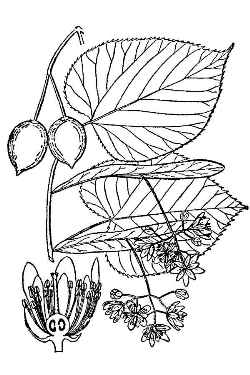
Tilia americana, Herman, D.E. et al. 1996. North Dakota tree handbook. USDA NRCS ND State Soil Conservation Committee;
Sunset®: 1-17
USDA: 4-8
Sun Exposure: Full sun to light shade
Origin: Northeastern USA, to Canada
Growth Habits: Deciduous tree, 75 to 130 feet tall (23-40 m); gray or brown bark, with long shallow furrows; ovate to cordate, dark green leaves, 4 to 8 inches long (10-20 cm), with pale underside
Flowers: Yellow flowers
Watering Needs: Regular water
Propagation: Seeds, cuttings, cultivar are propagated by bud grafting
Propagation: Seed or occasionally cutting, layering, grafting/budding
- by semi-hardwood secondary cuttings, in summer. Apply IBA TALC 3000 PPM. Use intermittent mist. It is helpful in rooting to apply heat to the bottom of the soil..
- by mound layers.
- by 'T' grafts, in late summer. Scion-rootstock compatibility between linden species is critical.
- by seeds, in spring. The seeds can be harvested in autumn. The seeds need stratify 40F in sand 3mo..

Tilia americana, Herman, D.E. et al. 1996. North Dakota tree handbook. USDA NRCS ND State Soil Conservation Committee;

Tilia americana, Britton, N.L., and A. Brown. 1913. Illustrated flora of the northern states and Canada. Vol. 2: 512. Courtesy of Kentucky Native Plant Society.
Blooming Habits:
Small pale yellow flowers, in late spring or early summer, with a narrow persistent leaf-like bract, about 4 inches long (10 cm)
Fruiting Habits:
The fruit is dry, hard, with gray-brown hair, 0.2 to 0.28 inch in diameter (5-7 mm), containing one or two seeds. It matures in early fall.
Culture:
Remove the suckers
Desert-Tropicals is dedicated to provide gardening advice, gardening ideas, and information about flower of all kind for landscape and collections.We try to check carefully the identification of the plants on the illustrations as well as the other information from the page, but occasionally errors do occur. if you notice anything that needs to be changed please contact us.Thanks.
© 1998-2020 Philippe Faucon, All Rights Reserved.